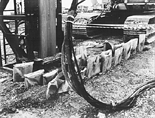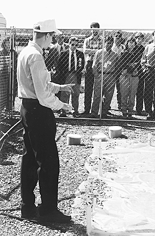


About the focus areas The U.S. Department of Energy's Office of Environmental Management has established an integrated approach for addressing waste issues based on problem, or focus areas. The focus areas are: subsurface contaminants; mixed waste characterization, treatment, and disposal; high-level waste tank remediation; decontamination and decommissioning; and plutonium stabilization. Three crosscutting technology areas support the focus areas: characterization, monitoring, and sensor technology; efficient separations and processing; and robotics.
The subsurface contaminants focus area is the newest focus area, formed in late September 1996 when the contaminant plumes containment and landfill stabilization focus areas merged (see Initiatives, June 1996). SCFA's mission is to develop, demonstrate, and deploy innovative systems for containing and isolating buried waste and remediating subsurface contaminates, including dense non-aqueous phase liquids, metals, and radionuclides. SCFA technologies will reduce risk and the cost of remediation while meeting compliance requirements. Opportunities for SCFA-developed technologies to improve DOE's environmental management mission are significant because of the enormous magnitude of the environmental problem. DOE's inventory includes:
Initial estimates of the cost and time to address this environmental management problem were as great as $230 billion over 75 years. The SCFA program develops technologies that will allow completion of the environmental restoration and solid waste management portions of this program more quickly and cost effectively.
SCFA uses a four-step process to identify end-user needs and technology solutions in its mission area.
This four-step process revealed that SCFA technology development needs fell into four main categories, which have become the product lines of the focus area:
The source-term remediation product line will develop technologies capable of remediating waste disposal sites posing a continuing threat to surface or ground water. The source-term containment product line's strategic goal is to contain contaminant sources that pose an imminent threat to surface or ground water. The DNAPL product line's goal is to delineate DNAPL contamination in the subsurface and to remediate DNAPL-contaminated soils and ground water in complex hydrogeologic settings. The radionuclides and metals product line is working to demonstrate technologies to remove the full range of radionuclide and metal contaminants found in soils and ground water throughout the complex. Activities within the SCFA program are designed to have all these development programs completed by 2005.
SCFA has supported development of more than 30 technology systems and has advanced a number to maturity and commercialization. Given the emphasis on expedited remediation, SCFA is promoting full development, demonstration, and deployment of mature technologies. SCFA highlighted some of its mature, successful technology systems in a display that debuted at Spectrum '96. All these projects are collaborative efforts designed for commercial use, such as mining and civil engineering applications or subcontractor use for costeffective cleanup at multiple contaminated DOE sites. Industry participation is an essential component of this technology deployment process.
Dig-face Characterization is the real-time use of data produced by geophysical, chemical, and radiological sensors deployed on a remotely controlled and monitored platform system (see Initiatives, June 1995). Characterization data are interpreted on-line in real time to identify hazards during an excavation.
Cooperative Telerobotic Retrieval is a remotely operated sundering and vacuum system that will be used to remove soil and debris from around waste objects. Two robotic manipulators can perform other tasks, such as retrieving containers and deploying dig-face characterization equipment and a suite of retrieval support tools. This telerobotic system allows for a much longer and continuous period of retrieval operation. American Crane and Equipment developed the delivery system, and Cinetrix, Inc. and Schilling Development expanded the control system. Concepts Engineering Group supplied the sundering and vacuum system, and Dimension Technologies supplied the stereovision.
Cryogenic Barriers are impermeable, frozen underground walls installed to prevent the further spread of subsurface contaminants from leaking underground tanks and dumps (see Initiatives, August 1996). The barrier planned for emplacement at the U.S. Department of Energy's Oak Ridge Reservation will be constructed by circulating an environmentally safe refrigerant solution through subsurface piping, causing water to freeze in the pores of the soil and creating an impermeable barrier. This in situ containment method significantly slows the migration of tritium to allow it to decay before release to the environment.
Subsurface Barrier Emplacement consists of placing a grout barrier beneath an existing waste site without disturbing the waste form. Two emplacement technologies have been tested: permeation and jet grouting. The anticipated benefit of installed barriers is that the waste volume will remain fixed, allowing additional time to develop remedial treatments.
 Electro-Osmosis, or LASAGNA is named for its
layered structure of electrodes and treatment zones (see Initiatives,
February 1995). It is an insitu treatment technology in which
established geotechnical methods are used to install treatment
zones and electrodes directly into low-permeability soil. Electro-osmosis
is used to move the contaminants dissolved in ground water through
the treatment zones, where they are either adsorbed or destroyed.
Electro-Osmosis, or LASAGNA is named for its
layered structure of electrodes and treatment zones (see Initiatives,
February 1995). It is an insitu treatment technology in which
established geotechnical methods are used to install treatment
zones and electrodes directly into low-permeability soil. Electro-osmosis
is used to move the contaminants dissolved in ground water through
the treatment zones, where they are either adsorbed or destroyed.
A LASAGNA demonstration began August 13 at Paducah, Kentucky and continued for three months. On September 17, SCFA and the DOE Paducah site office offered the public a tour of the LASAGNA test site at Paducah's Solid Waste Management Unit 91, Cylinder Drop Test Site. During the tour, SCFA and DOE presented information on the LASAGNA technology and heard from potential users, regulators, and community leaders about issues and concerns that should be addressed to make LASAGNA deployable at other DOE and commercial sites. More than 90 people participated in the tour, including technology users, regulators, and community leaders from 20 states across the country. The tour was supported by the Rapid Commercialization Initiative, a group of federal, state, and industry partners working to streamline commercialization of the LASAGNA technology. If the current demonstration is successful, Paducah plans to use LASAGNA to clean up the entire Cylinder Drop Test Site.
In-Well Vapor Stripping reduces risk by removing volatile organic compounds from aquifers without workers' having to handle contaminated water at the surface. The system converts contaminated ground water into a vapor stream that can be treated easily at the surface. This technology has been successfully demonstrated at Edwards Air Force Base, California and at the TNX Basin at the Savannah River Site. This system has been licensed to EG&G Environmental, which is commercializing the technology. Because this technology doesn't pump fluids to the surface, a significant component of the total remediation cost is avoided.
Enhanced Uranium Recovery focuses on accelerating the cleanup of uranium-contaminated ground water at the Fernald Environmental Management Project. The technologies will also have application at many other sites, including DOE's 26 Uranium Mine Tailings Remedial Action sites. The goal is to investigate the application of commercial in situ leaching technologies. The benefit of these technologies is a significant reduction in the duration of aquifer remediation projects.
The Resource Recovery Project covers several pilot-scale technologies
designed to recover marketable metal products and clean water
from heavy metals–contaminated water. Thousands of abandoned
mines contribute to ground and surface water contamination. These
technologies mitigate the environmental threat from these and
other industrial  sources. During 1995,
IBC Advanced Technologies, Inc. demonstrated its Molecular Recognition
Technology System at the Berkeley Pit Superfund Site in Butte,
Montana (see Initiatives, June 1996). In the demo, five separate
units were used to sequentially remove copper, iron, aluminum, zinc,
and manganese as metal sulfates. A sixth unit was used to polish
the water to meet regulatory standards. This project also includes
the testing at the Berkeley Pit of Arctech Inc.'s Humasorb and
Selentec's MAG SEP (see Initiatives, August 1995 and October
1996).
sources. During 1995,
IBC Advanced Technologies, Inc. demonstrated its Molecular Recognition
Technology System at the Berkeley Pit Superfund Site in Butte,
Montana (see Initiatives, June 1996). In the demo, five separate
units were used to sequentially remove copper, iron, aluminum, zinc,
and manganese as metal sulfates. A sixth unit was used to polish
the water to meet regulatory standards. This project also includes
the testing at the Berkeley Pit of Arctech Inc.'s Humasorb and
Selentec's MAG SEP (see Initiatives, August 1995 and October
1996).
The Counsel of Energy Resource Tribes has chosen SCFA to develop a prototype program for tribal input to the environmental restoration program. SCFA has also established a cooperative working relationship with representatives of the Community Leaders Network. CLN's SCFA subgroup leader is Kelly Kaletsy of the Ohio Environmental Protection Agency. SCFA works with governmental liaison agencies, such as the Western Governors' Association and the Southern States Energy Board, to promote acceptance of innovative technologies.
![]()
![]()
![]()